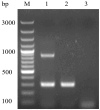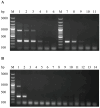The Development of a One-Step PCR Assay for Rapid Detection of an Attenuated Vaccine Strain of Duck Hepatitis Virus Type 3 in Korea
- PMID: 39852883
- PMCID: PMC11768531
- DOI: 10.3390/vetsci12010008
The Development of a One-Step PCR Assay for Rapid Detection of an Attenuated Vaccine Strain of Duck Hepatitis Virus Type 3 in Korea
Abstract
Duck hepatitis A virus type 3 (DHAV-3) is a viral pathogen that causes acute, high-mortality hepatitis in ducklings, and vaccination with attenuated live vaccines is currently the main preventive measure against it. However, differentiating infected from vaccinated animals (DIVA) is crucial for clinical diagnosis and effective disease control. This study aimed to develop a rapid mismatch amplification mutation assay PCR (MAMA-PCR) diagnostic method to simultaneously detect and differentiate between wild-type and vaccine strains. The method was specifically designed to target the critical single-nucleotide polymorphism (SNP) site (T→C at position 1143 in the VP0 gene) unique to the Korean vaccine strain AP04203-P100. MAMA-PCR demonstrated high sensitivity and specificity, with detection limits as low as 102.4 ELD50/mL for wild strains and 100.5 ELD50/mL for vaccine strains, and showed no cross-reactivity with 11 other common duck pathogens. The clinical sample results were completely consistent with those obtained using nested PCR detection and gold-standard sequencing. In summary, we successfully developed a rapid, one-step MAMA-PCR method that is more suitable for clinical diagnosis than traditional sequencing methods.
Keywords: differentiating infected from vaccinated animals; duck hepatitis A virus type 3; mismatch amplification mutation assay; rapid diagnostic.
Conflict of interest statement
Authors Hyung-Kwan Jang and Min Kang were employed by Bio Disease Control (BIOD) Co., Ltd. The remaining authors declare that the research was conducted in the absence of any commercial or financial relationships that could be construed as potential conflicts of interest.
Figures





Similar articles
-
Establishment and Application of Mismatch Amplification Mutation Assay-PCR for Rapid Detection and Differentiation of Duck Hepatitis A Virus-1 Attenuated Vaccine and Wild Strains.Animals (Basel). 2024 Sep 21;14(18):2733. doi: 10.3390/ani14182733. Animals (Basel). 2024. PMID: 39335322 Free PMC article.
-
Detection, differentiation, and VP1 sequencing of duck hepatitis A virus type 1 and type 3 by a 1-step duplex reverse-transcription PCR assay.Poult Sci. 2014 Sep;93(9):2184-92. doi: 10.3382/ps.2014-04024. Epub 2014 Jul 10. Poult Sci. 2014. PMID: 25012848
-
Development of the first officially licensed live attenuated duck hepatitis A virus type 3 vaccine strain HB80 in China and its protective efficacy against DHAV-3 infection in ducks.Poult Sci. 2024 Oct;103(10):104087. doi: 10.1016/j.psj.2024.104087. Epub 2024 Jul 11. Poult Sci. 2024. PMID: 39094497 Free PMC article.
-
Current status and future direction of duck hepatitis A virus vaccines.Avian Pathol. 2023 Apr;52(2):89-99. doi: 10.1080/03079457.2022.2162367. Epub 2023 Jan 19. Avian Pathol. 2023. PMID: 36571394 Review.
-
Hepatitis Virus Infections in Poultry.Avian Dis. 2016 Sep;60(3):576-88. doi: 10.1637/11229-070515-Review.1. Avian Dis. 2016. PMID: 27610716 Review.
References
-
- WOAH . Manual of Diagnostic Tests and Vaccines for Terrestrial Animals. 12th ed. WOAH; Paris, France: 2024. [(accessed on 4 November 2024)]. Duck Virus Hepatitis. Chapter 3.3.6. Available online: https://www.woah.org/fileadmin/Home/eng/Health_standards/tahm/3.03.06_DV....
LinkOut - more resources
Full Text Sources

